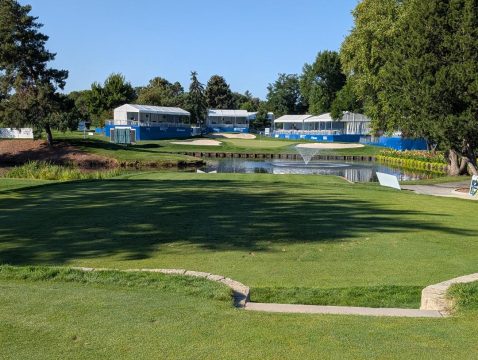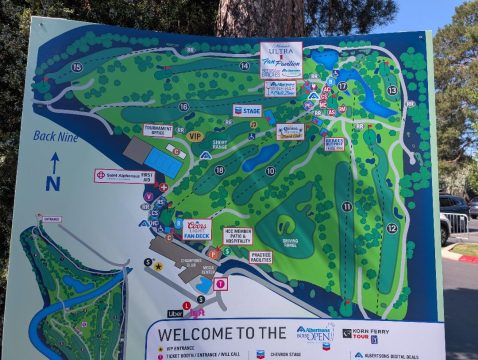BOISE — There’s watching golf and there’s there are WAYS TO WATCH THE GOLF, if you understand the nuance. Anyone can go to the tournament, but maximizing your enjoyment is the ultimate goal.
What are you looking for? Golf action? The beer tent? The party scene? People watching? Being watched? If you’re going the Korn Ferry playoffs this week in sizzling Boise, Idaho – both the scene and the weather! – forewarned is forearmed.
THE BOISE ALBERTSONS OPEN AND THE KORN FERRY TOUR FINALS
Just like the PGA Tour has the FedEx Cup, the Korn Ferry Tour has the Korn Ferry Tour Finals, their season-ending, points race-based lead up to the Korn Ferry Tour Championship. While the pros play East Lake Country Club in Georgia for their finale, it’s Indiana’s Pete Dye-designed French Lick course for the Korn Ferry guys, who are just one short step away from the Big Time — the lights, cameras, action, and cash of the PGA Tour.
LISTEN TO GOLF NEWS NET RADIO 24/7
FOLLOW GOLF NEWS NET RADIO: iHEART | TUNEIN
This week is the last stop before the four-event Finals series starts, so there is everything to play for in the final regular-season event, the Boise Albertsons Open at Hillcrest Country Club.
HILLCREST COUNTRY CLUB
Hillcrest Country Club’s 18 holes are the product of three different designers. An original nine holes was created by George Otten, a native of Portland, Oregon, who enjoyed a modest regional success in his home city but not much acclaim beyond. An additional nine were added by A.V. Macan, and he was one of the biggest names in golf design west of the Mississippi River.
Macan was a giant who, sadly, is vastly underrated for two reasons: the majority of his work was in the Pacific Northwest and much of it was private. But no less a personage than Robert Trent Jones, Jr. said about Macan, “If Mac had decided to live on the east coast in 1912 and started his business there he would have been just as famous as Ross, Tillinghast, MacKenzie and [Stanley] Thompson. And when it comes to green design and construction Vernon Macan was a generation ahead of us all. He knew how to design a green so the wedge player could not get close to the pin. This is what we are trying to accomplish today.”
Doubtless, Macan revolutionized golf architecture in the Pacific Northwest over a career spanning five decades, and his pioneering efforts resulted in more than 40 critically acclaimed courses. Most importantly, his arrival on the west coast triggered a Golden Age of golf course architecture in the region, and set the standard for a generation of other Pacific Northwest designers such as John Harbottle, Dan Hixson, and David McKay Kidd. As one pundit wrote 50 years ago, and it still rings true today, “If you were from the Pacific Northwest, Vernon Macan determined how you played the game for fifty years.”
Macan is responsible for creating the front nine the golfers will play this week. Otten designed the what the golfers will play this week as the inward nine. However, a major caveat appears: intervening architect Robert Muir Graves.
For our purposes, the course that exists today is the dramatic renovation of Graves, another designer who made his name on the West coast. Known better for his mentoring young designers, his honesty and earnestness in business, and his giving the client what they wanted rather than for his individual golf architectural principles, Graves was a product of his generation. His golf courses don’t show you anything you’ve never seen. Moreover, they generally follow the principles of the Doctrine of Framing, rather than the Doctrine of Deception. Graves did a complete restoration of the golf course during the middle 1960s, the heyday of penal golf architectural and target-style courses. The course we find today is a typical example of the golf architecture of the period.
And that’s exactly what pro golfers like. This tournament is supposed to be a birdie-fest. Who has got the most talent? That’s the question posed by both the course and the setup. There are no nasty pot bunkers with names at Hillcrest. There is no mortally terrifying hazard with waves crashing to the shore. There is no Oakmont-like rough with Winged Foot-esque green speeds. This tournament is about scoring, not thinking your way around the course.
“They’ll have to get off to a good start as they get two par 5s right out of the gate at two and three,” notes Hillcrest PGA Head Golf Professional Brian McKinley, and he’s right. Architecturally speaking, back-to-back par 5s are a wonderful rarity, showing that the architect adhered to the Golden Age principle of letting the land determine the routing. From a pro’s point of view, it’s a steak dinner waiting to be eaten. Who wouldn’t dream of opening a round 3-3-3, birdie-eagle-eagle?
Indeed, the par 5s are the first line of attack, though here are only three of them. Hillcrest plays to an asymmetric par of 36-35, another example of the club’s architectural roots. A par 3 over water follows the two par 5s, so this early run of holes will see wild swings. It might be a great idea for spectators to park themselves by either the third or fourth green to see action on both holes, even perhaps the tee shots on the fifth hole as well. Imagine going 6 under for your first four holes of the day. That’s how hot a start we could see.
“The holes from 10-14 will be where the players will face the most serious challenges on the back nine,” noted McKinley. “Then it’s finish strong on 15-18.”
No. 11 in particular, a brawny 462-yard par 4, will prove especially difficult off the tee as the players have a long carry into a tree-lined fairway set at an awkward angle.
Nos. 15-18 is where the majority of the spectator grandstands are located as well, but that means that spectators will be free to roam the rest of the golf course. About 15,000 spectators are expected each day. The par-3 17th always proves to be a popular viewing spot — another par 3 over water with hero or zero awaiting the golfer.
 THE WATERY 17TH MAY SINK SOME HOPES THIS WEEKEND
THE WATERY 17TH MAY SINK SOME HOPES THIS WEEKEND
THE PLAYERS
Some folks prefer to sit down all day in one place and watch the golf from that spot, even if it’s 12 hours long, and they’ll line up for hours beforehand to run and get a good seat. But there’s another way catch the most action – pick some players or groups to follow. Who do I suggest? I asked Ryan Ballengee of The Road to French Lick and Golf News Net. He said, “Just look at the Points List.” So here are the top 35 names:
1. Johnny Keefer
2. Austin Smotherman
3. Neal Shipley
4. Hank Lebioda
5. S.H. Kim
6. Davis Chatfield
7. Chandler Blanchet
8. Pierceson Coody
9. Trace Crowe
10. Christo Lamprecht
11. Kensei Hirata
12. Emilio Gonzalez
13. Sudarshan Yellamaraju
14. Mitchell Meissner
15. Pontus Nyholm
16. Julian Suri
17. Jeremy Gandon
18. S.T. Lee
19. Josh Teater
20. Justin Suh
21. Myles Creighton
22. Alvaro Ortiz
23. Logan McAllister
24. Kyle Westmoreland
25. Ross Steelman
26. Kevin Dougherty
27. Adrien Dumont de Chassart
28. Jeffrey Kang
29. Zach Bauchou
30. Rick Lamb
31. Bryson Nimmer
32. Cole Sherwood
33. Ian Holt
34. Robby Shelton
35. Nicolo Galletti
So now all you do is grab a starter’s tee time sheet, look at the alphabetical section, and go find the players or groups you want to watch. As for me, I’ll start by watching Neal Shipley, Davis Chatfield, and Christo Lamprecht. And because he makes the “All Name Team,” Adrien Dumont de Chessart.
 GRANDSTANDS ARE LOCATED AT HOLES 10 AND 15-18.
GRANDSTANDS ARE LOCATED AT HOLES 10 AND 15-18.
CONCERTS
Jeff Sanders is a rock star by nature, so why not put two great tastes that taste great together, golf and music? Concerts will always be a staple and highlight of the week, and this year is no exception. All concerts will be adjacent to the 18th fairway and general admission, starting at 7:30 pm. Tickets are supposedly sold out, but you never know when some last-minute tickets might get released. Also check the secondary market.
Thursday – Darius Rucker
Friday – Lynyrd Skynyrd
Saturday – Brothers Osbourne
FOOD
Nothing beats the Latin sabor of Argentinian steakhouse barbacoa. By far and away, it’s the finest food and experience in the Treasure Valley. Absolutely an imperative, it is not to be missed.
If you want Italian red sauce, you’re certainly in the right place, because the best — indeed, only — place in all of southern Idaho is down the street from the tournament. Luciano’s on Orchard Street, right in the middle of everything, and just steps from the golf this week is the most authentic Italian ristorante in the region. The parms are the size of your arm, the bowls of pasta endless, and the la dolce vita palpable. For those who like their Italian swerved with a side of fancy-schmancy, but no red sauce at all, Alavita downtown will not disappoint.
We do have some James Beard award winners in town, and Ansot’s Basque downtown is one. Some of the best sausages you’ve ever had get mad eon premises, and you can take home any one of four different flavors inclusing garlic and spicy.
WHO WAS ARTHUR VERNON MACAN?
Named after his physician father, Arthur Vernon Macan Jr. was born in Dublin,and educated as a young man at Shrewsbury School in England before enrolling at Trinity College in Dublin, where he studied Law. His father was an accomplished doctor, serving in the Prussian Army in the field. Macan Sr. later became lead physician at Dublin’s Rotunda Hospital, championing antiseptic procedures in midwifery, which would result in a significant decrease in birthing mortality. His wife died in 1886 when their son was only four.
According to lore, Macan’s first sporting love was cricket, but he was introduced to golf in 1905 and became a superlative player, undoubtedly one of the best golf-course architects who played the game, likely on the level of Pete Dye or Dan Maples, perhaps even Walter Travis. And he did all this while maintaining a Dublin law practice. A mere seven years after taking up the game, Mac – as he was universally known – won the British Columbia Men’s Amateur Championship in 1912 and would go on to retain the trophy 12 months later. He also won the Pacific Northwest Amateur and the Washington State Amateur championships in 1913. He enjoyed the particularly special privilege of playing matches with the Irish Bar Golfing Society against the Oxford & Cambridge Golfing Society.
Soon after his father died in 1908, Macan set off for Canada, most likely to visit a former golf partner and member of Victoria Golf Club who had emigrated. That same year, Macan was commissioned by a group of Victoria Golf Club members to build a new course that would eventually become Royal Colwood, one of only 69 royally designated courses in the world.
World War I interrupted those plans, and Macan volunteered for service in 1916 as an officer in the Canadian Army. He was wounded by a shell-casing fragment at the Battle of Vimy Ridge in France, and blood poisoning in his left foot resulted in the amputation of his lower left leg. He wore a prosthetic device and continued to play competitively as an amateur upon his return to Canada.
As gentlemen and ladies did in that day, they kept correspondence, and Macan was tight with such golf design luminaries of golf course architecture, including C.H. Alison and John Low, who was termed “his mentor.” Macan also credited Harry Colt, Willie Park Jr. and later Alister MacKenzie as influential figures in his design thoughts.
Arthur Vernon Macan was a prolific golf writer, and he carefully constructed detailed clay models of the holes he designed. He remained active in both writing and design until his sudden death in 1964 at age 82 while designing Sunland Golf Course in Sequim, Washington.
“Golf was for everyone,” he was quoted as saying. “The middle and high handicapper must be encouraged to go out and have an enjoyable day.”
Macan’s designs include Royal Colwood in Victoria, Canada, metro Vancouver courses Shaughnessy, Marine Drive and Richmond Country Club, and American designs Fircrest and Broadmoor in Washington and Columbia Edgewater in Portland. Alderwood Country Club in Portland, host of the 1937 US Amateur, no longer exists.
WHO WAS ROBERT MUIR GRAVES?
A former president of the American Society of Golf Course Architects, the ASGCA remembered Graves thusly:
“Graves enjoyed teaching others about the principles of golf architecture. He wrote extensively on topics relating to golf course design and was a visiting lecturer at the University of California Berkeley, University of Massachusetts, Utah State University and the Harvard Graduate School of Design. Graves partnered with Geoffrey Cornish for 16 years to teach the summer class at Harvard. He always looked forward to the week on the Cambridge campus and the new crop of students. The Graves/Cornish team was also popular within the golf industry where they conducted two-day seminars for the GCSAA and the PGA of America for many years. Much later in their careers the duo collaborated on two books, Golf Course Design and Classic Golf Hole Design. Graves also taught and hired Damian Pascuzzo, ASGCA, upon his college graduation. Pascuzzo eventually became Graves’ business partner, and the duo worked together until Graves’ retirement.”
According to his long-time design associate Neal Meagher, “Bob Graves was born in 1930 in Michigan, and decided not to follow his family career path, which I believe was dentistry. Instead, he gravitated towards landscape architecture, obtaining a degree in that field from Cal in 1953. He never worked for anyone. … So, he began to support his young and growing family of three girls and a very, very supportive wife, by slowly establishing a small practice that did residential landscape design, college master planning and the start of some golf work by the early 1960s. As there were far fewer golf architects in California at the time, competition for work was not what it currently is, which meant that he remained in the Bay Area for the next 30 years working primarily out of Walnut Creek and for a brief time in San Francisco. So, slowly he began to get full 18-hole design commissions to augment the myriad small and large renovation work that came his way.”
Graves and his contemporaries such as Ed Seay and Dick Phelps were Doctrine of Framing, penal-defense architects, very much a product of the television generation and the “harder is better” demands of greens committees and developers were obsessed with during the ’60s, ’70s and ’80s.
“This was a time that stressed utility over beauty and miserly construction and maintenance budgets over grandiose ones. Additionally, as often happens with many young designers, he was working at the behest of owners who requested the kinds of modifications that would help them keep the doors open by lowering costs,” continued Meagher. “However, it can be said that not all of his projects had severe budgetary constraints and toward the late 1970’s and into the 1990’s he was given some marvelous sites to work with and excelled, especially, at routing courses. Yet, I must say that a certain look and template could be found on many of his firm’s courses, namely shapely greens surrounded by cape and bay bunkers that lended themselves to streamlined maintenance.”
So you’ll see a mix of styles at Hillcrest. Some old school features remain like the Illusion Bunker at 10, which seems greenside from the fairway, but is actually 30 yards short. Still, you’ll also see plenty of 5:00, 7:00 bunkering greenside as well as some ramrod straight holes and fairway bunkers flanking the holes rather than presenting cross-hazards. New York Canal meanders drunkenly through several front nine holes, and will give players pause when calculating distances, but this is not a Doctrine of Deception golf course: What you see is what you get, so have at it.







